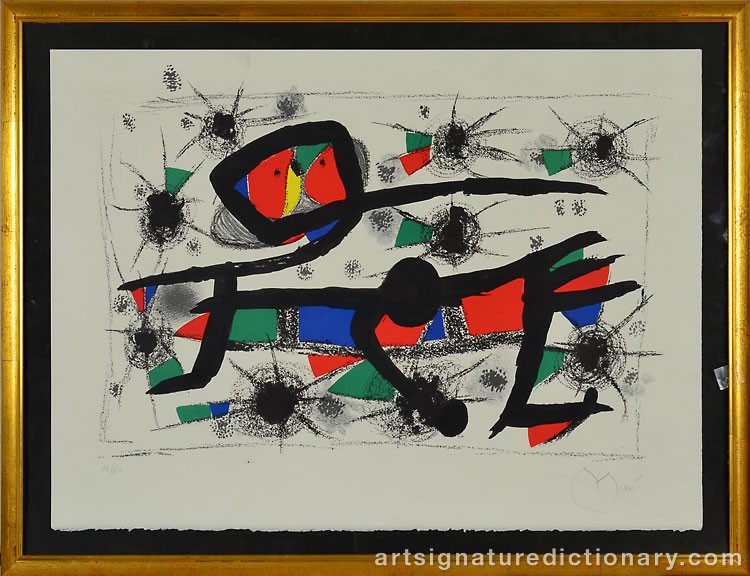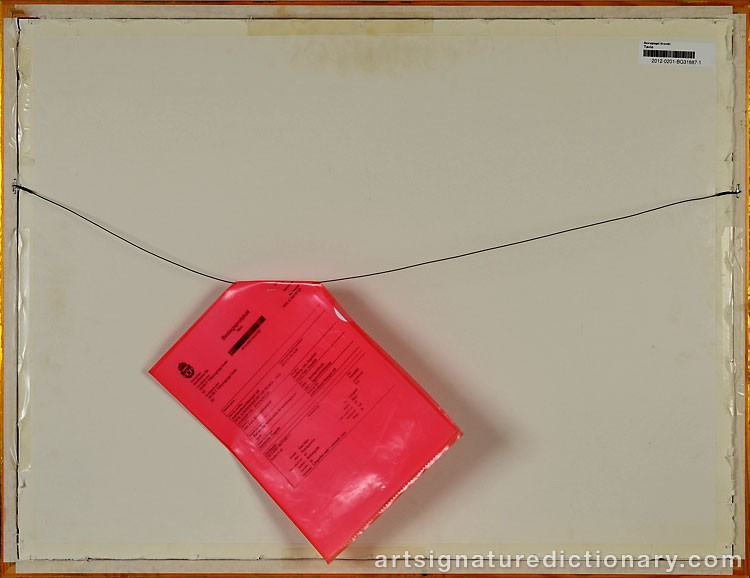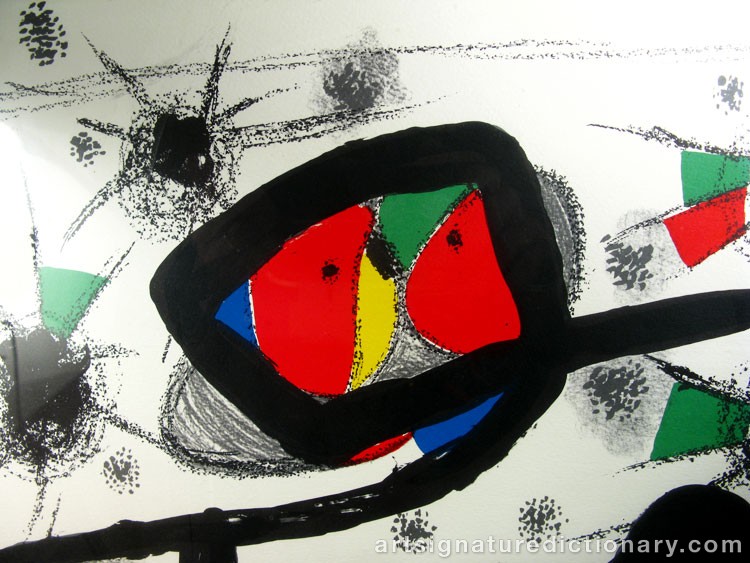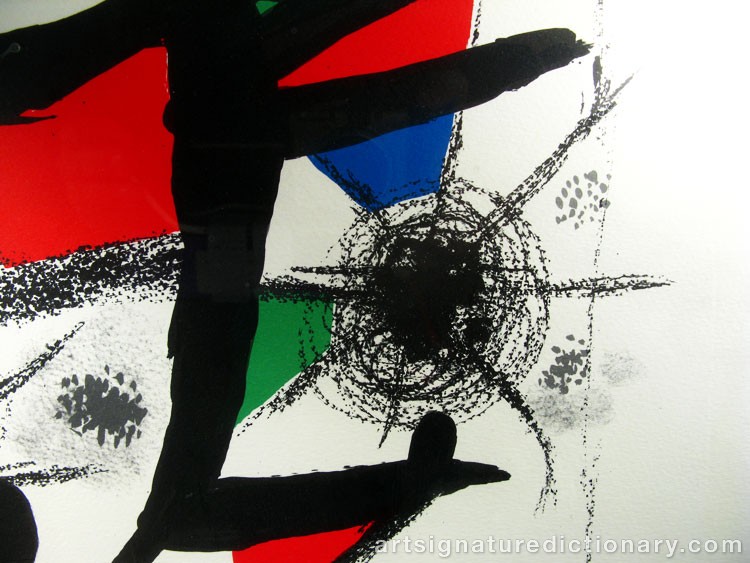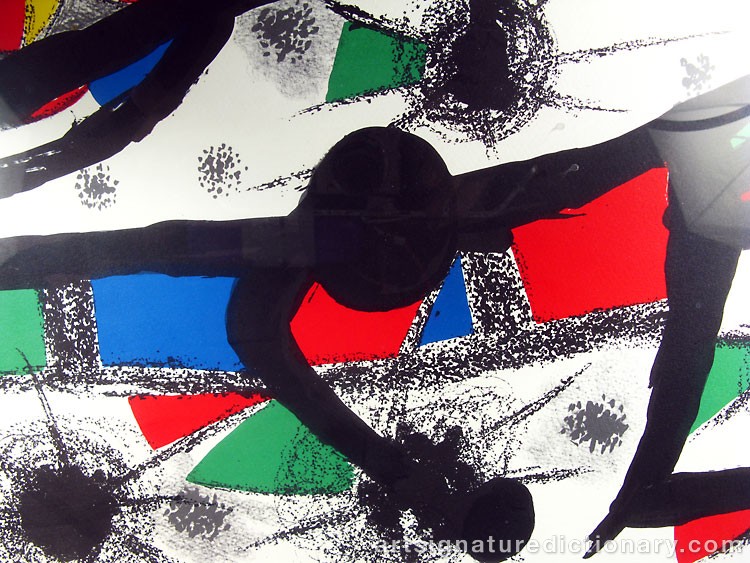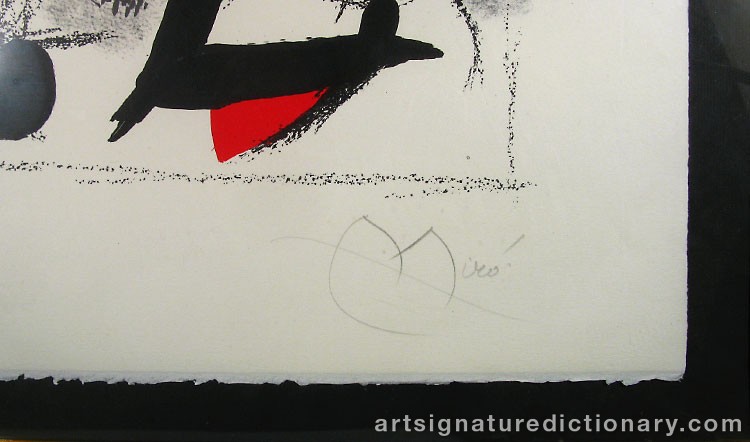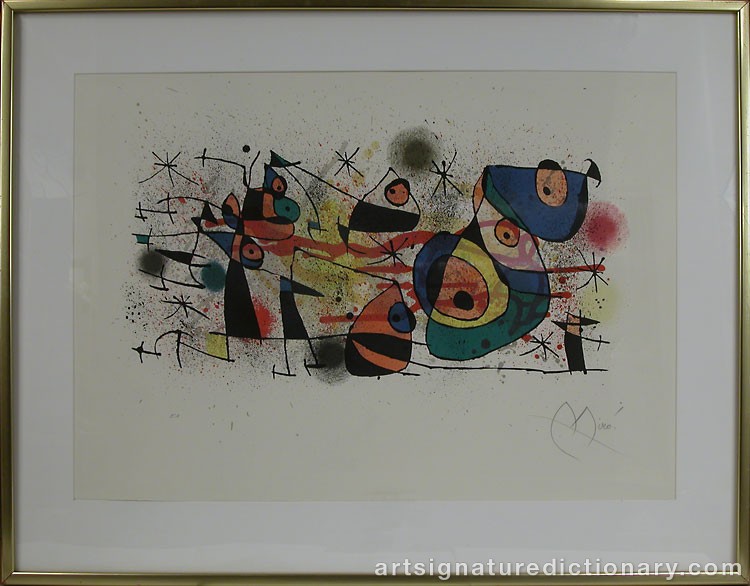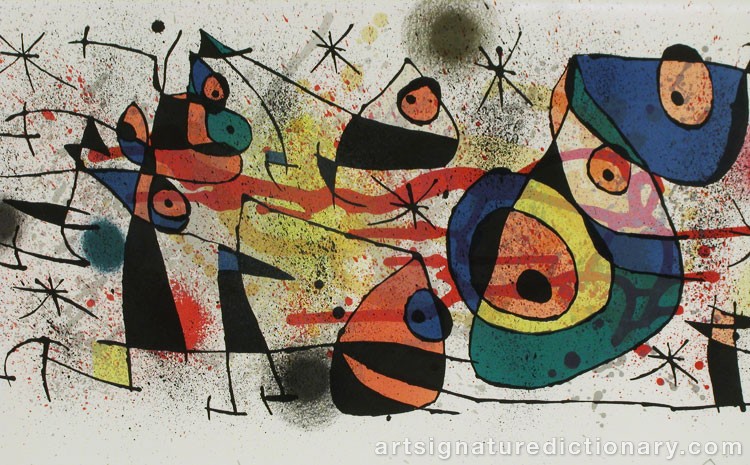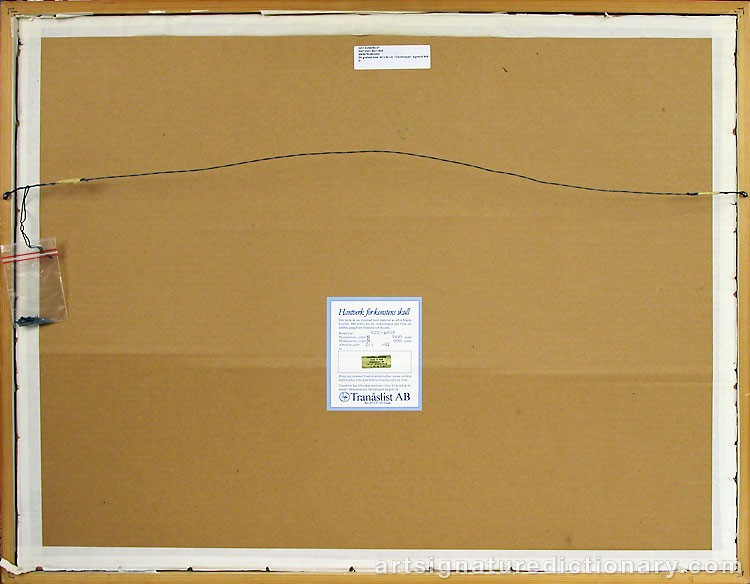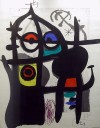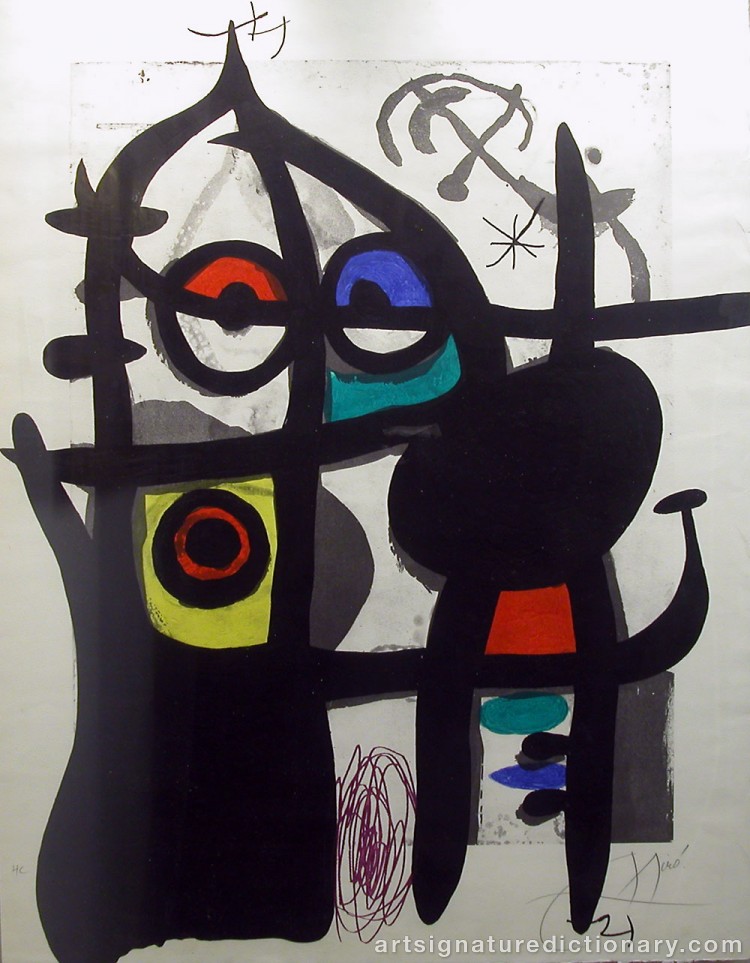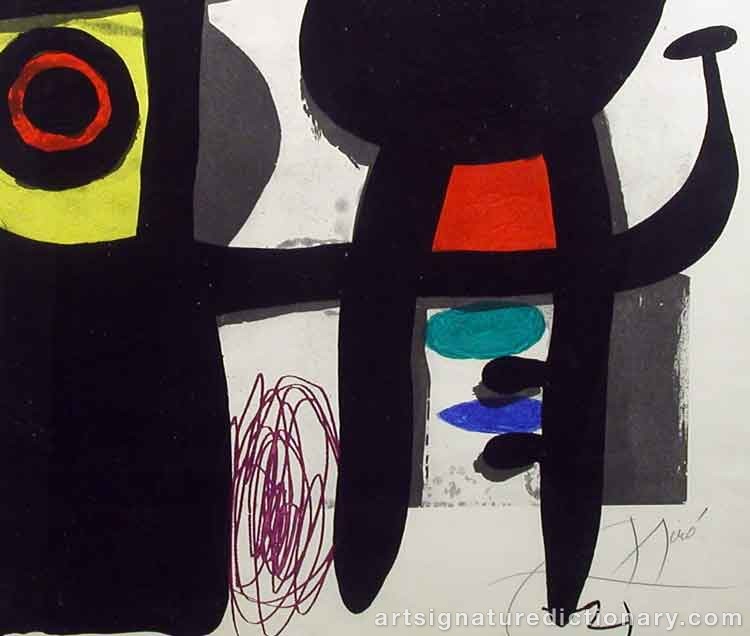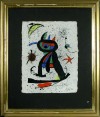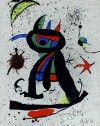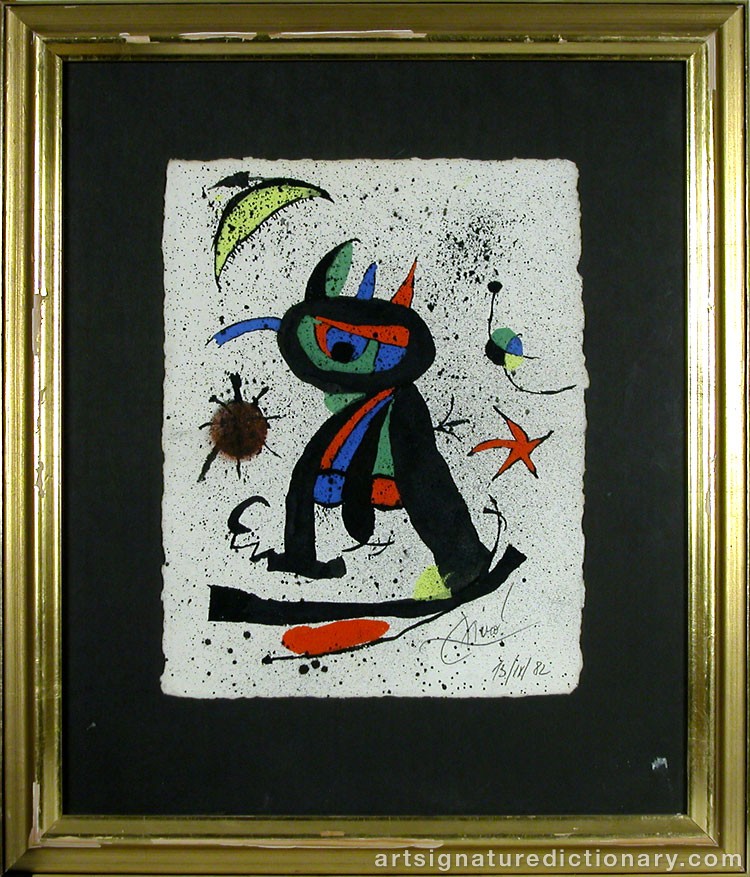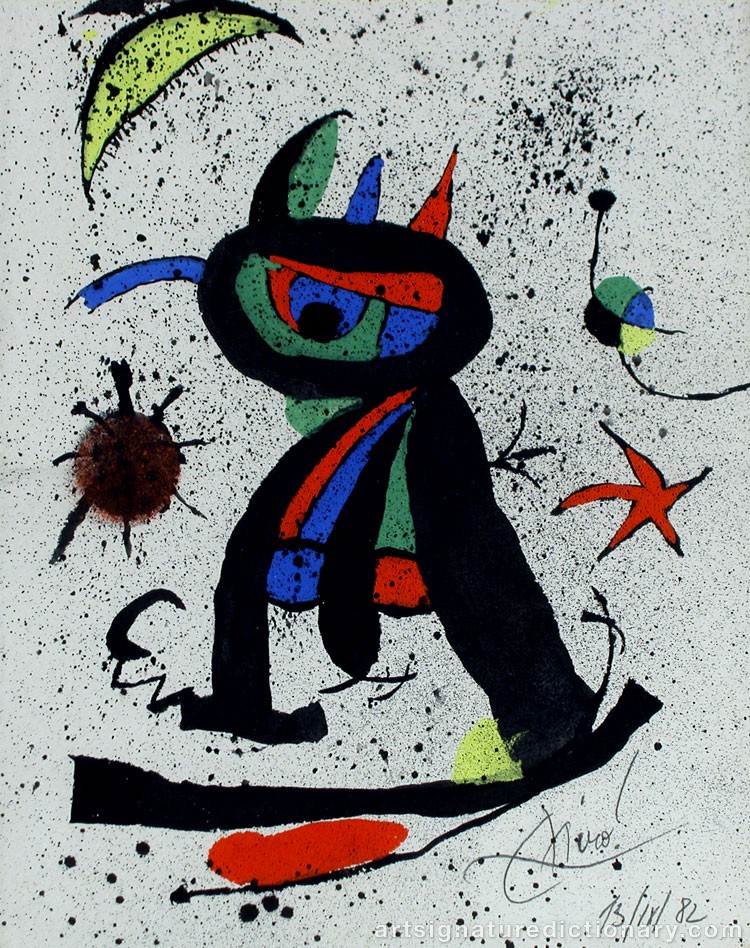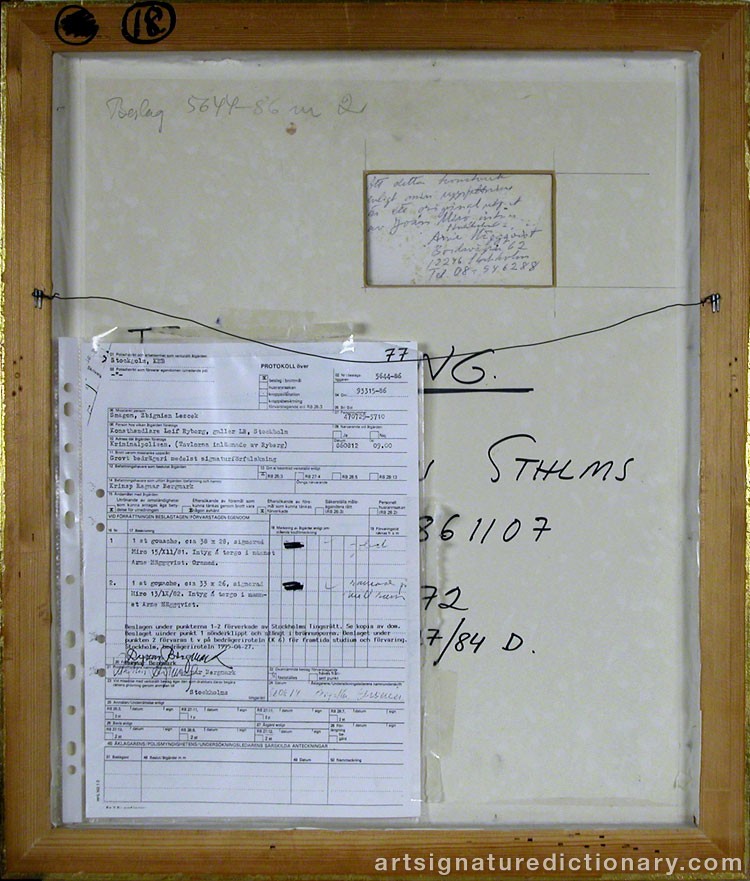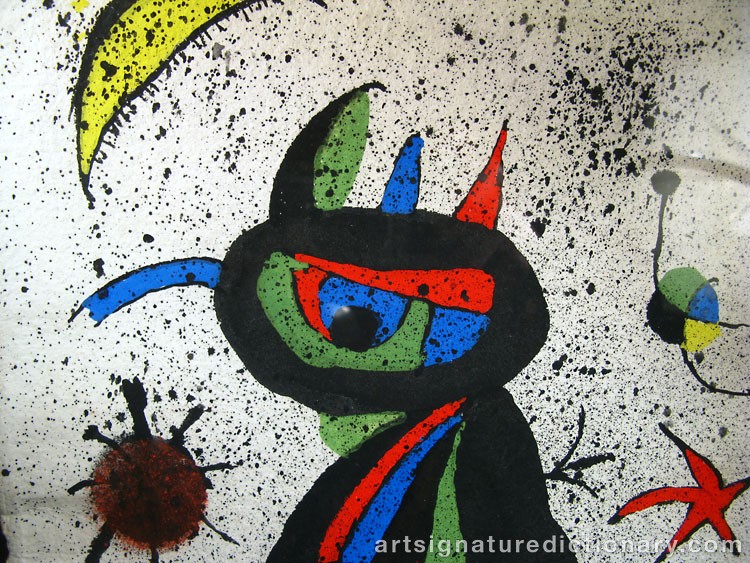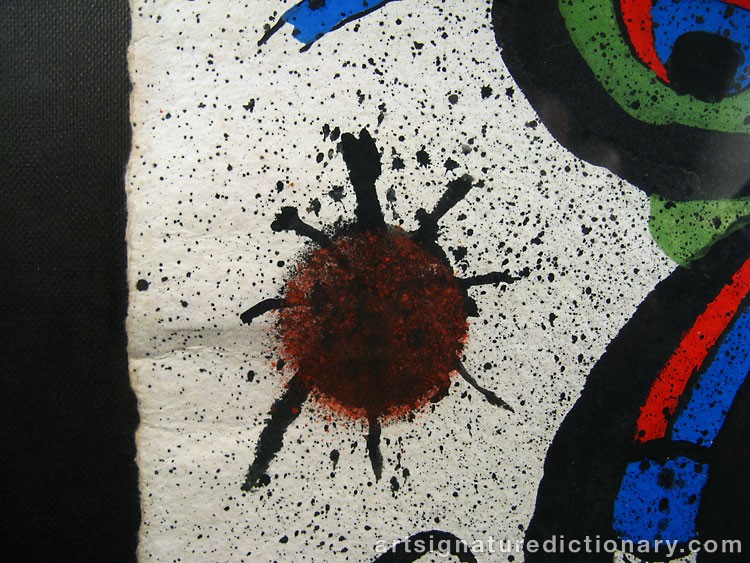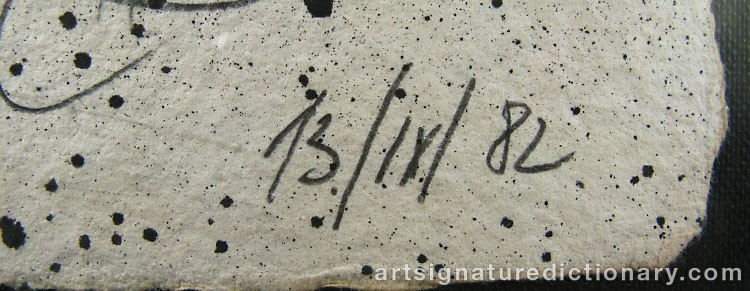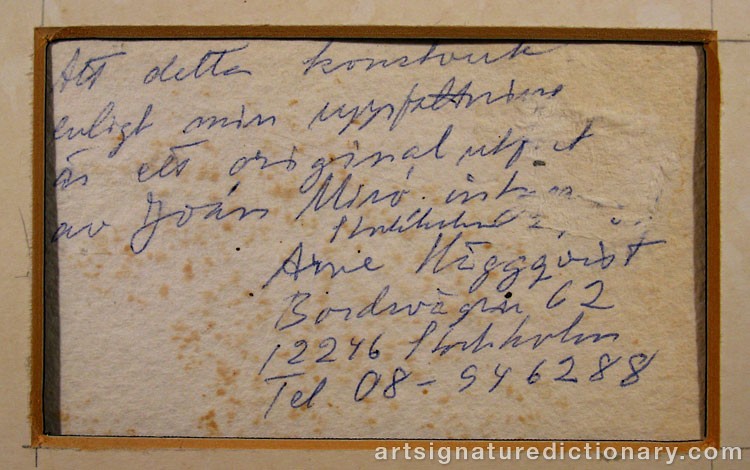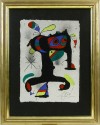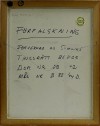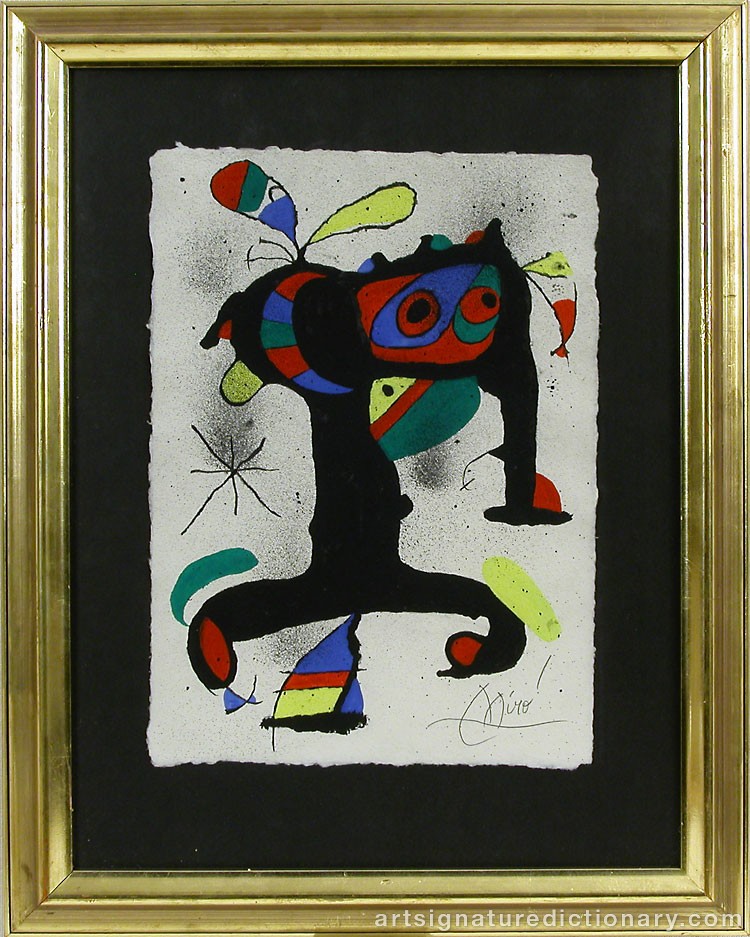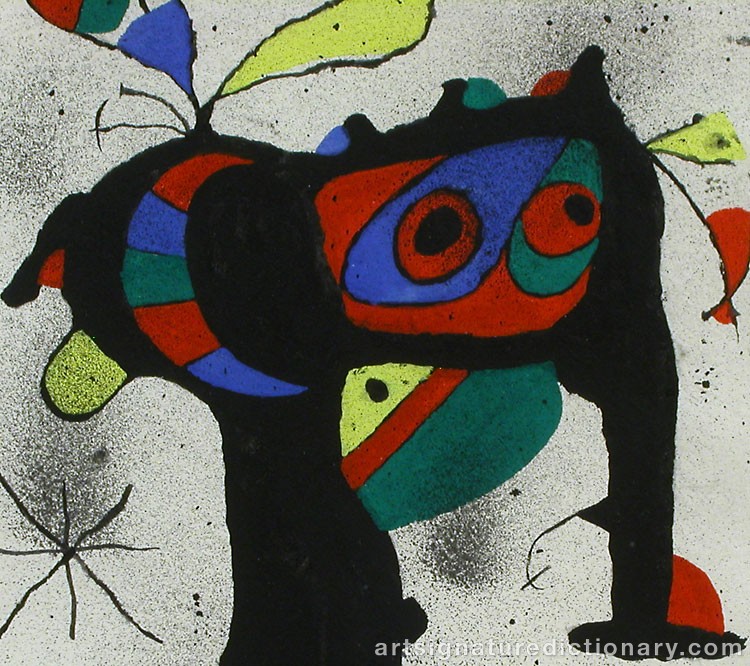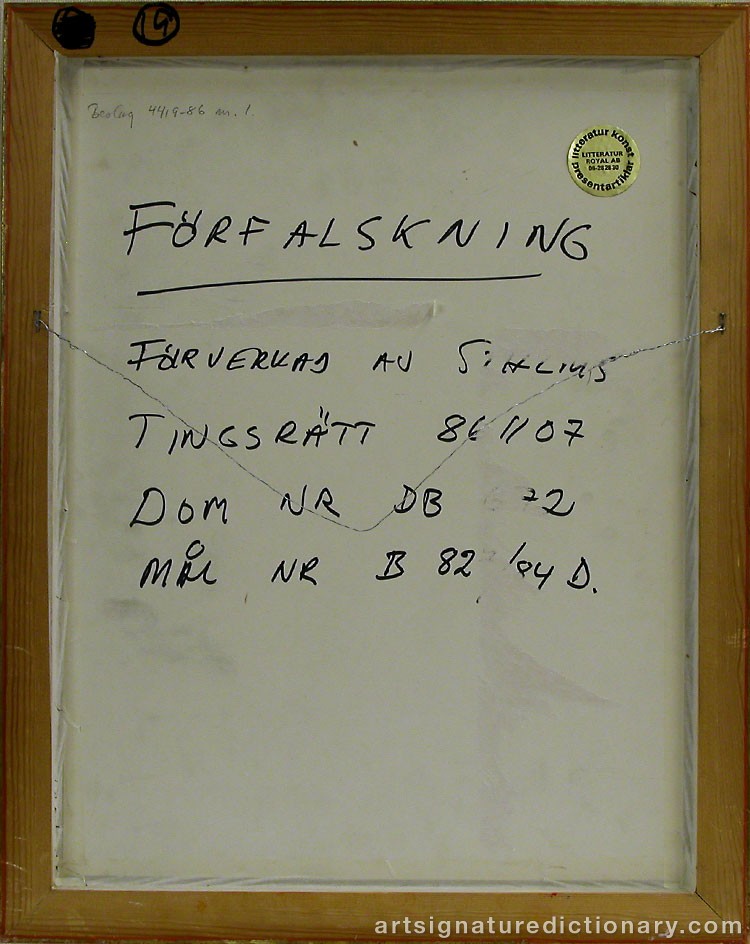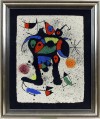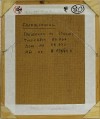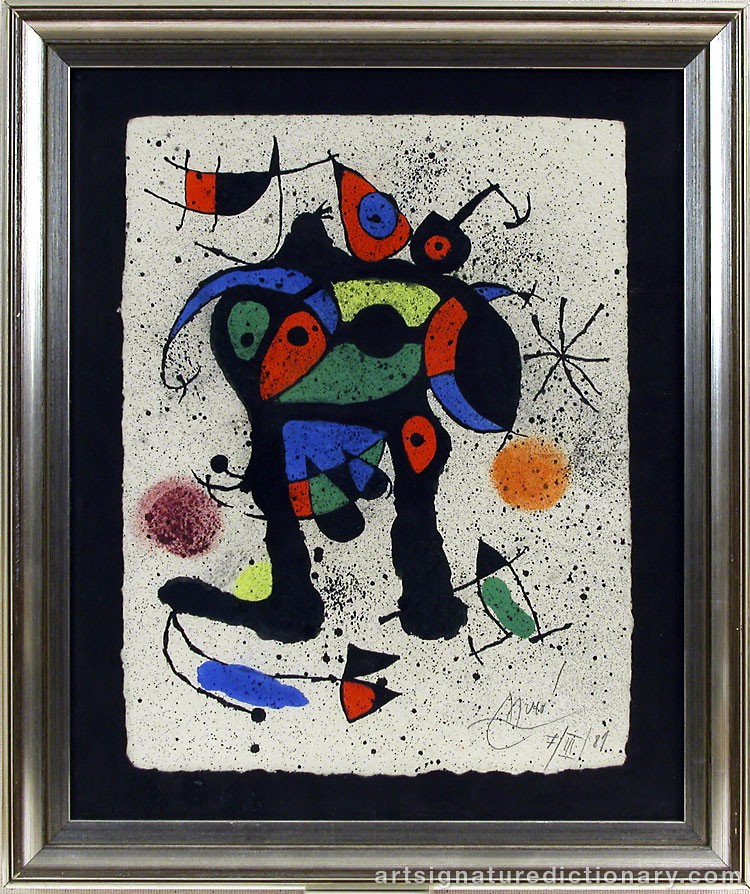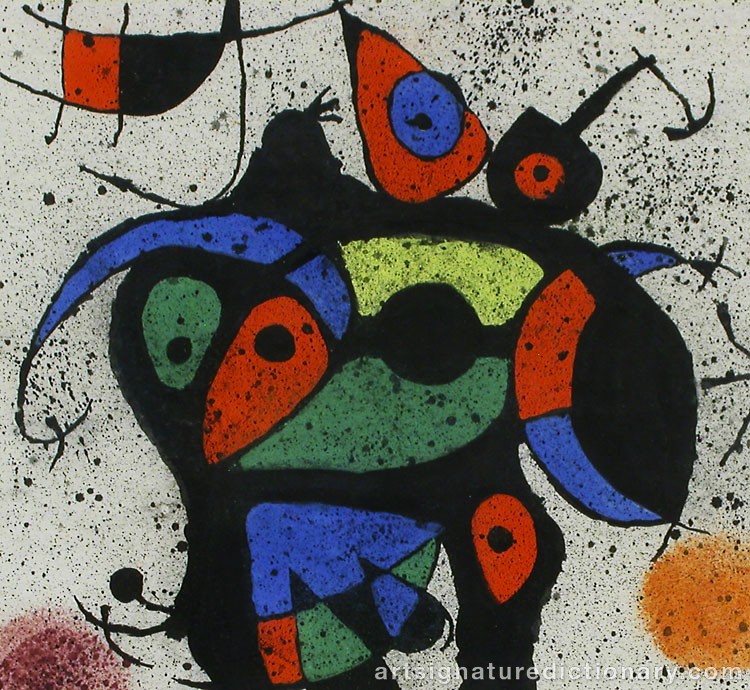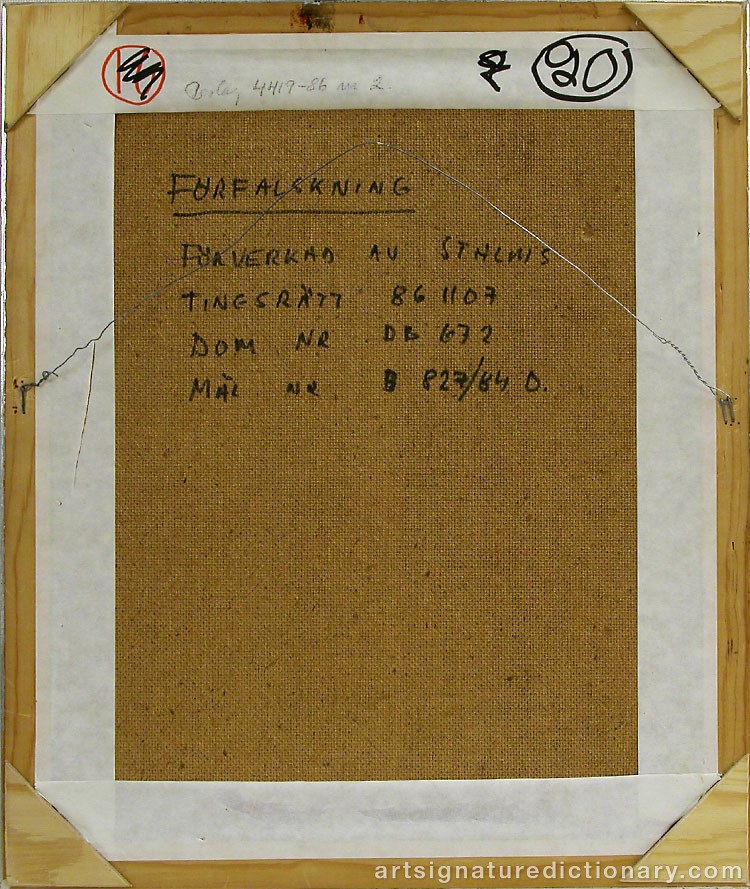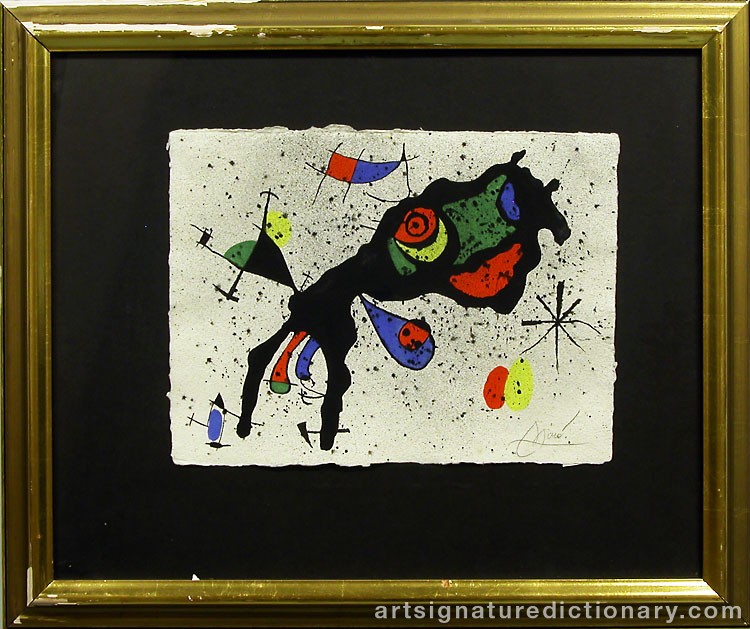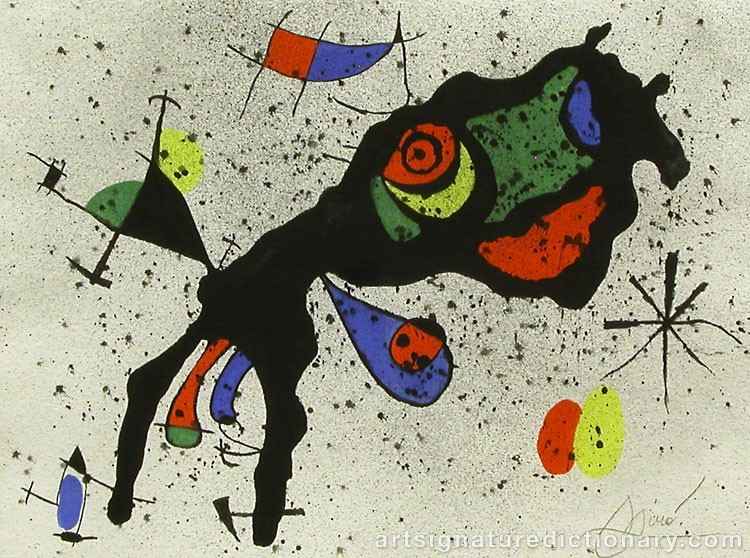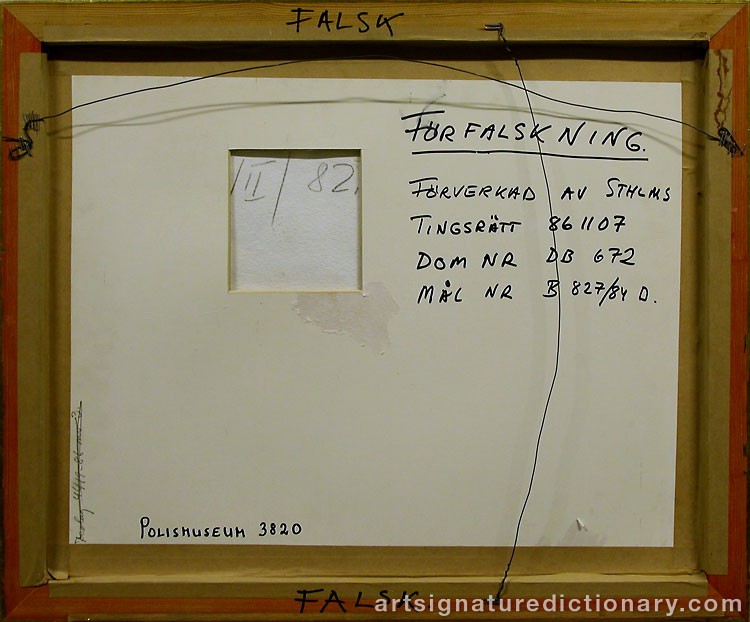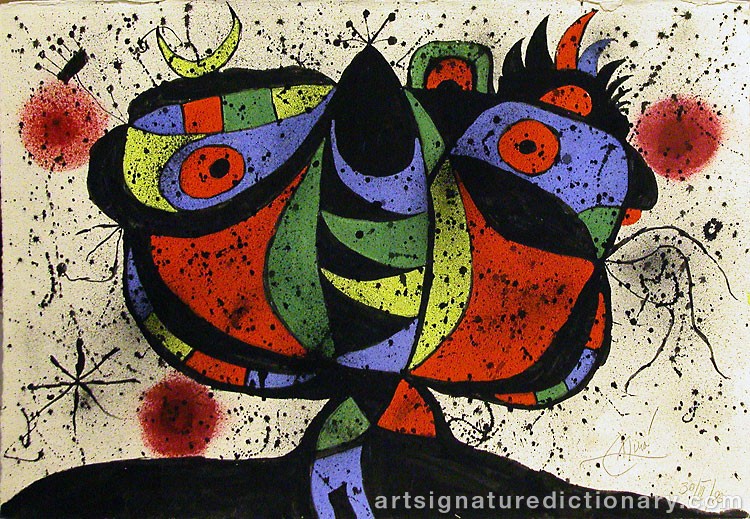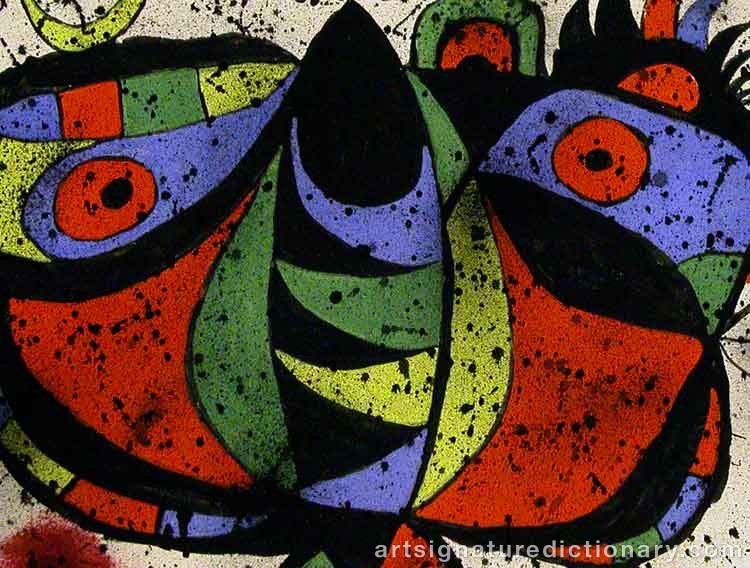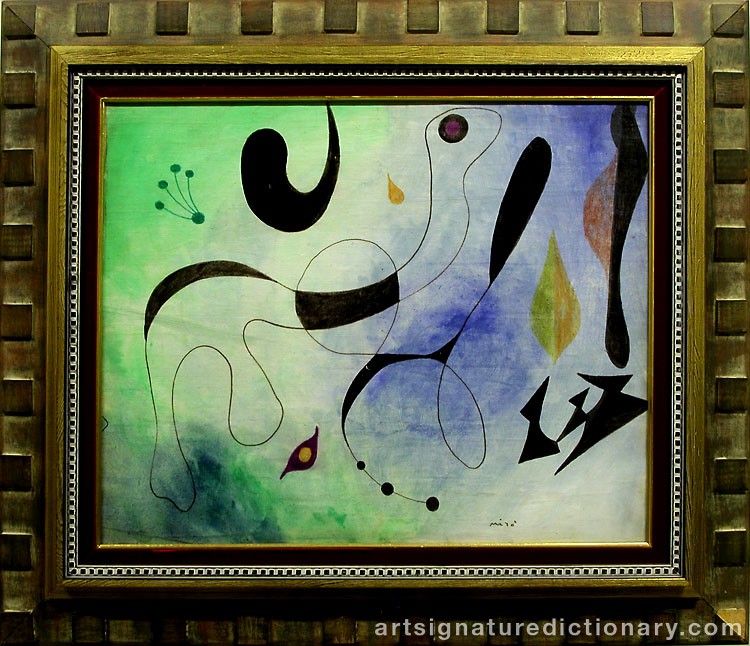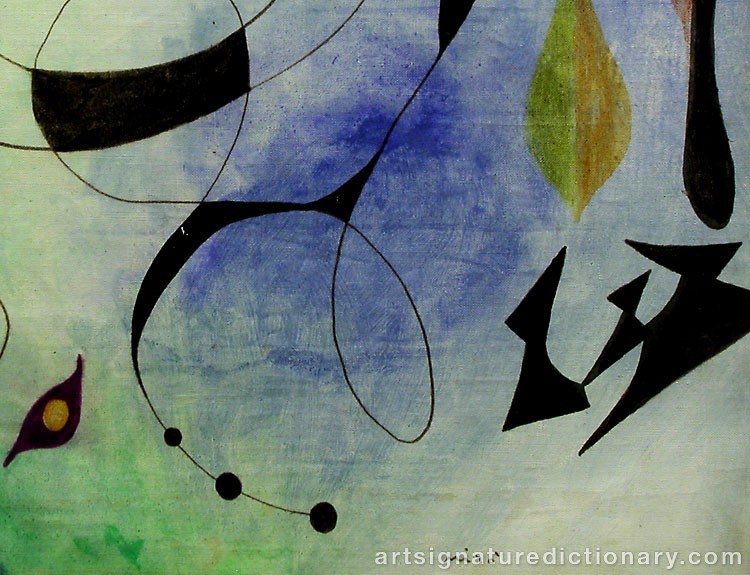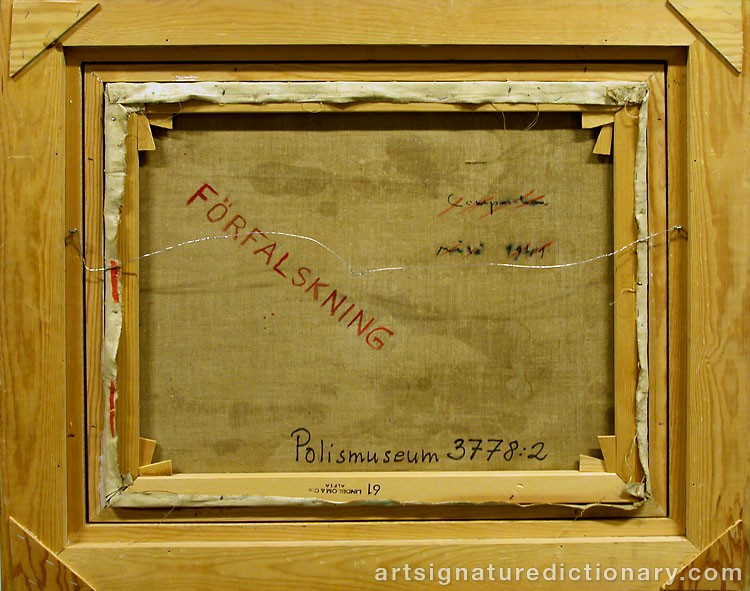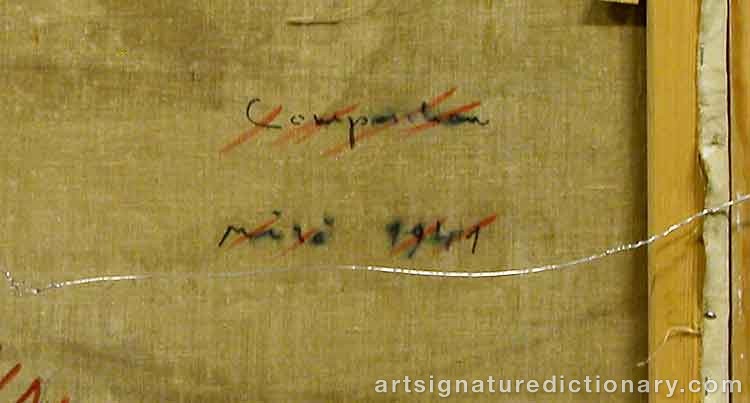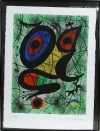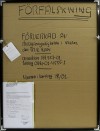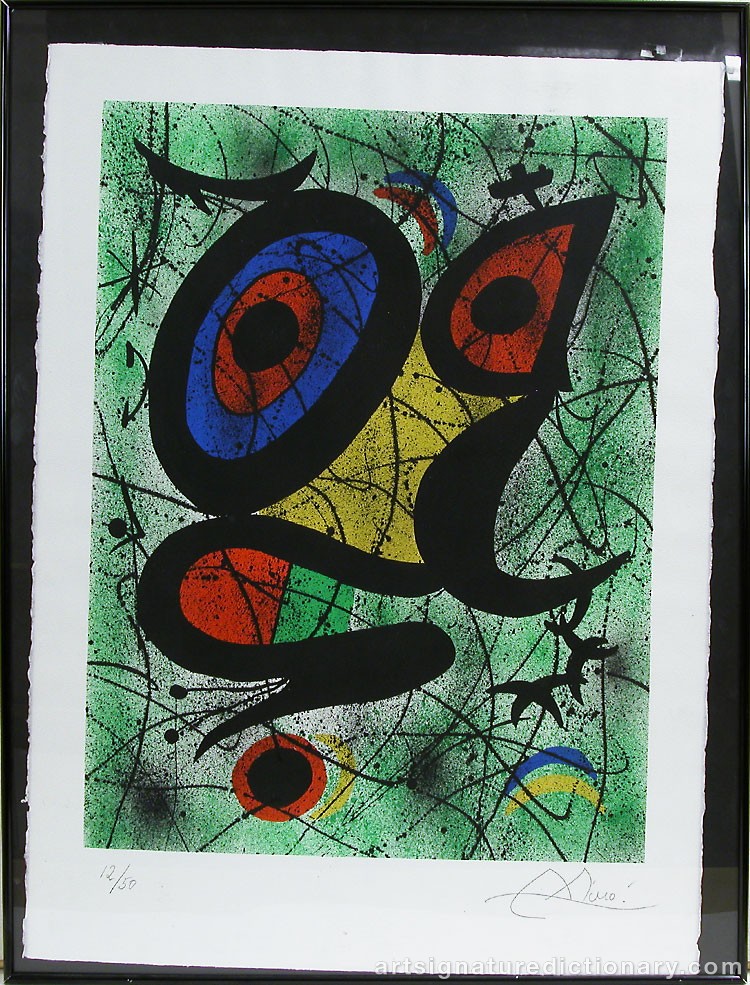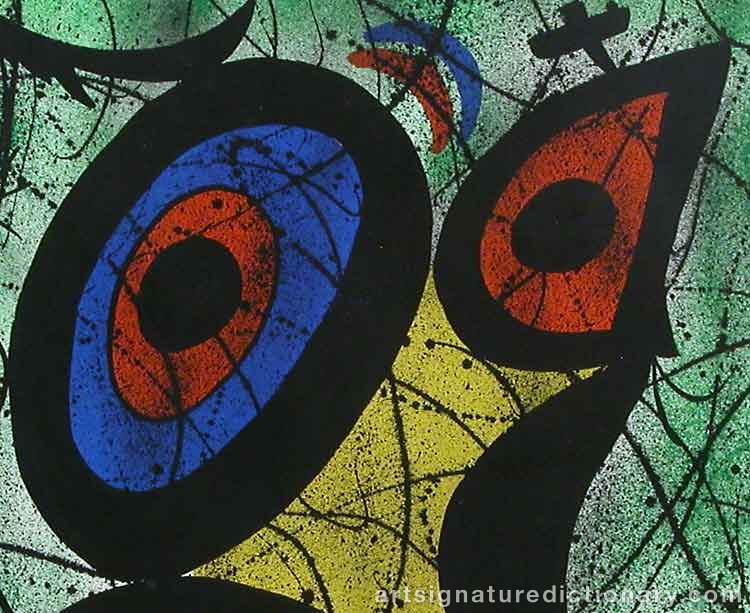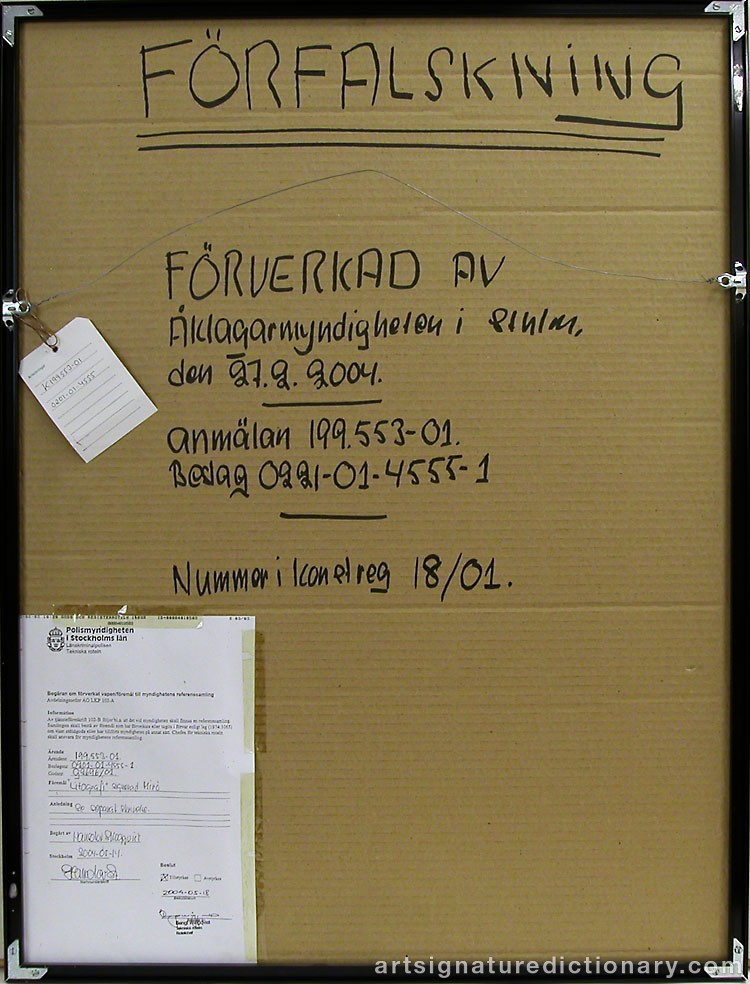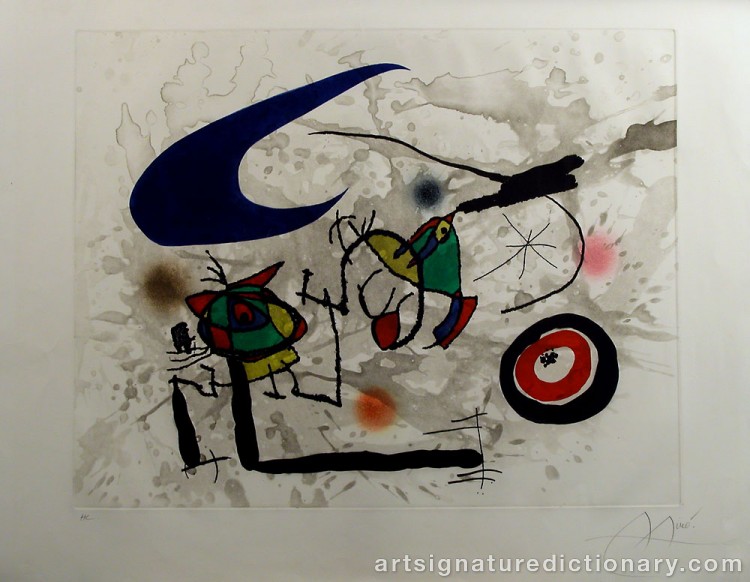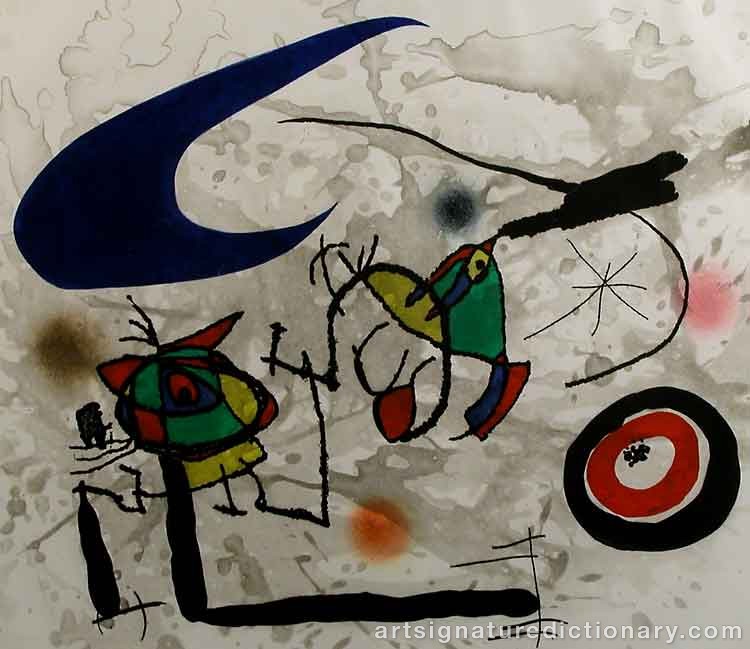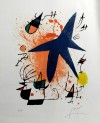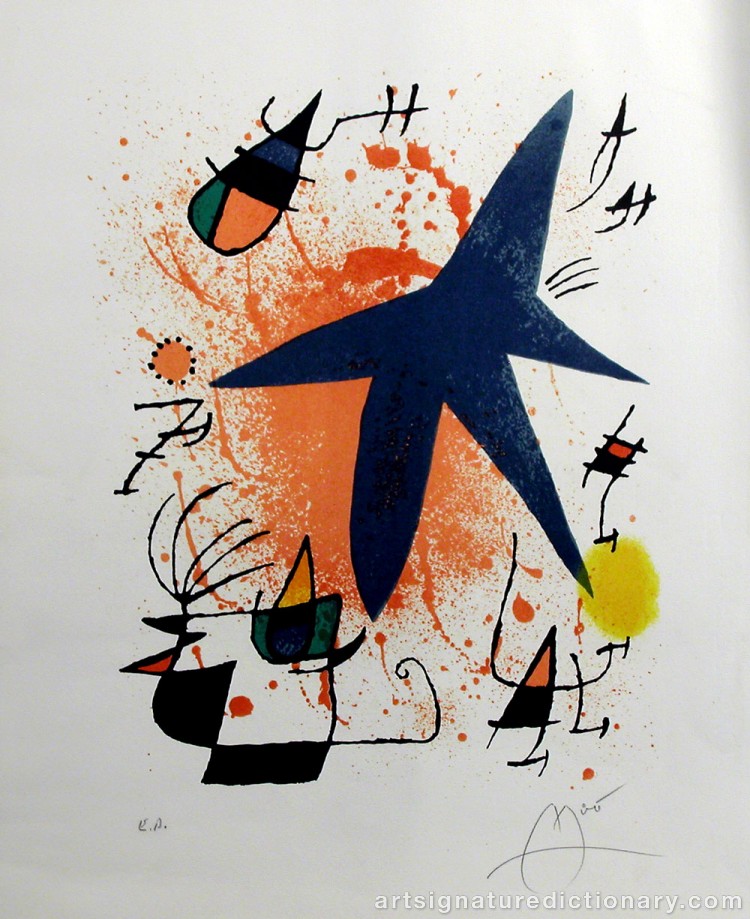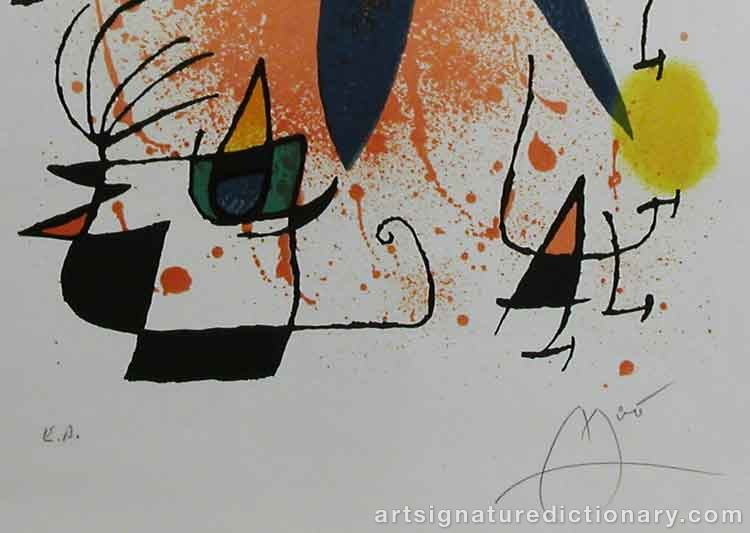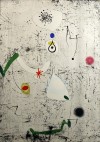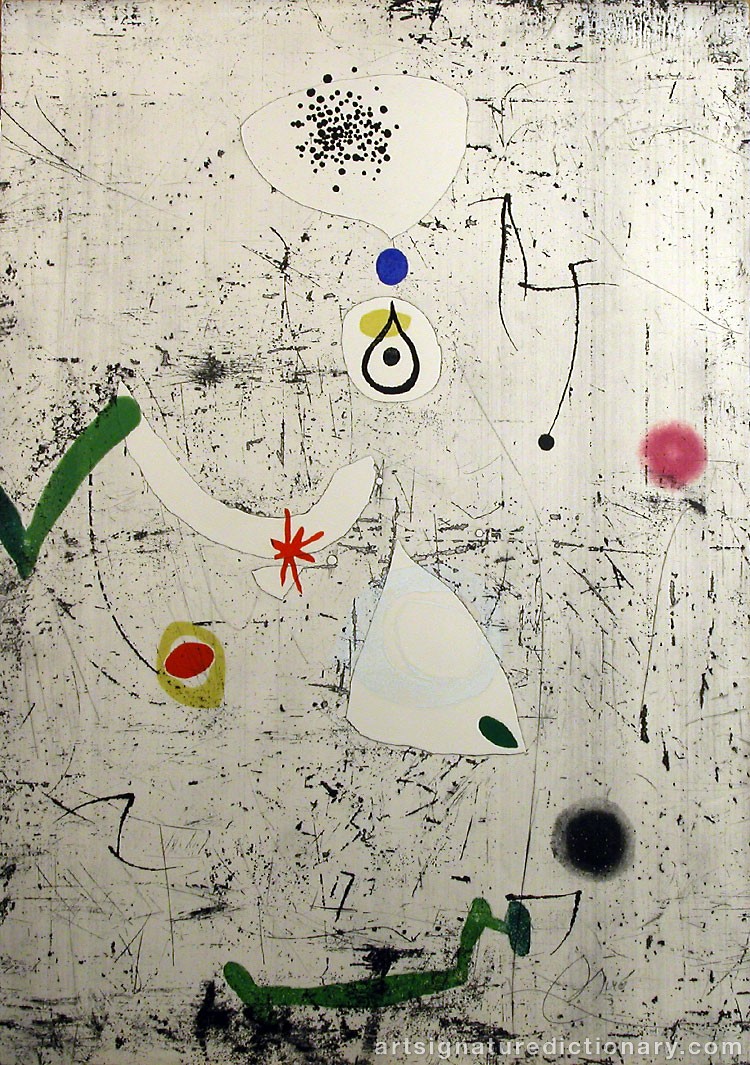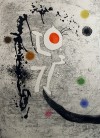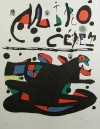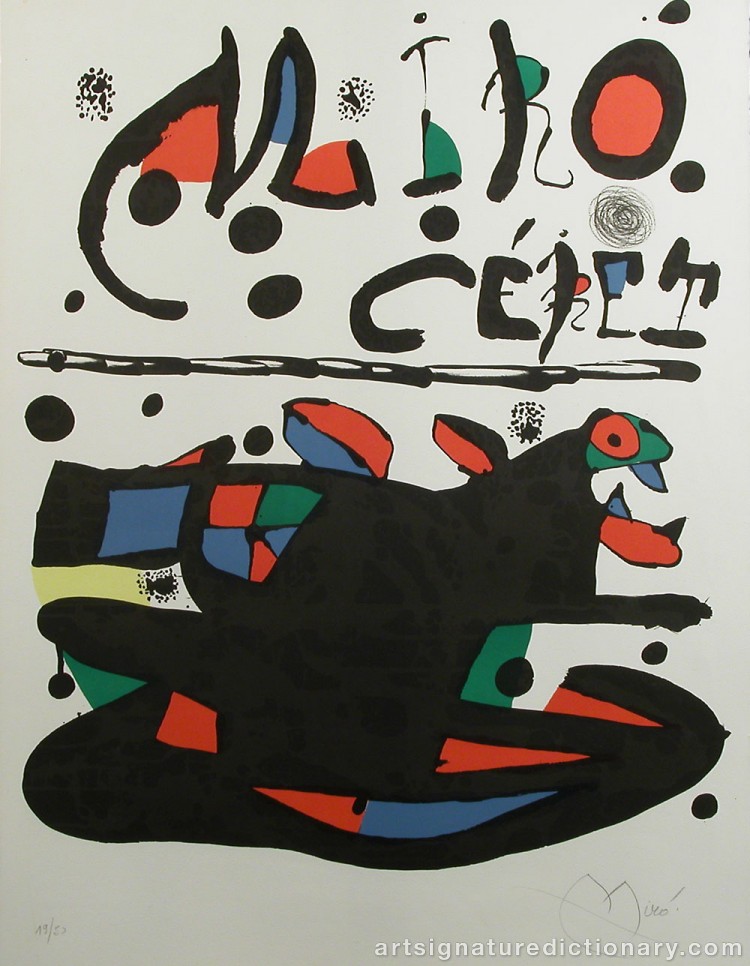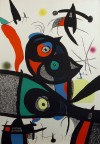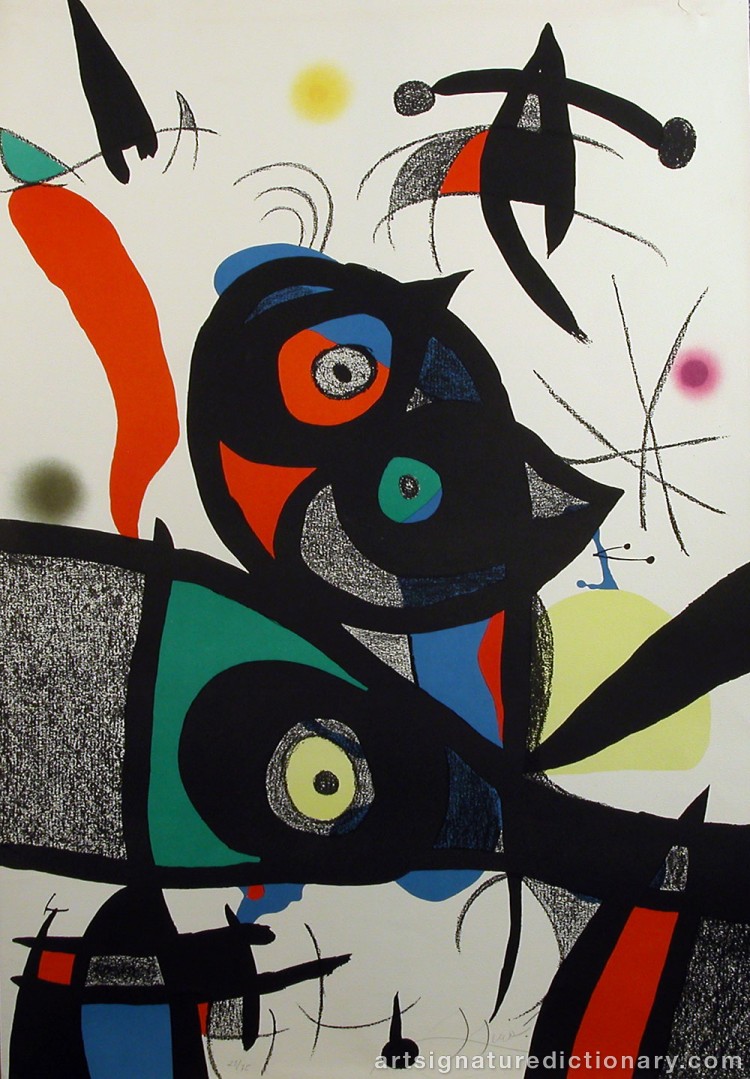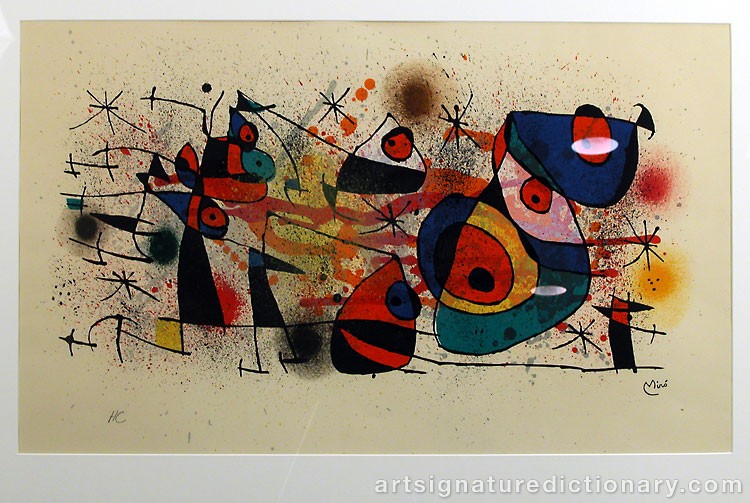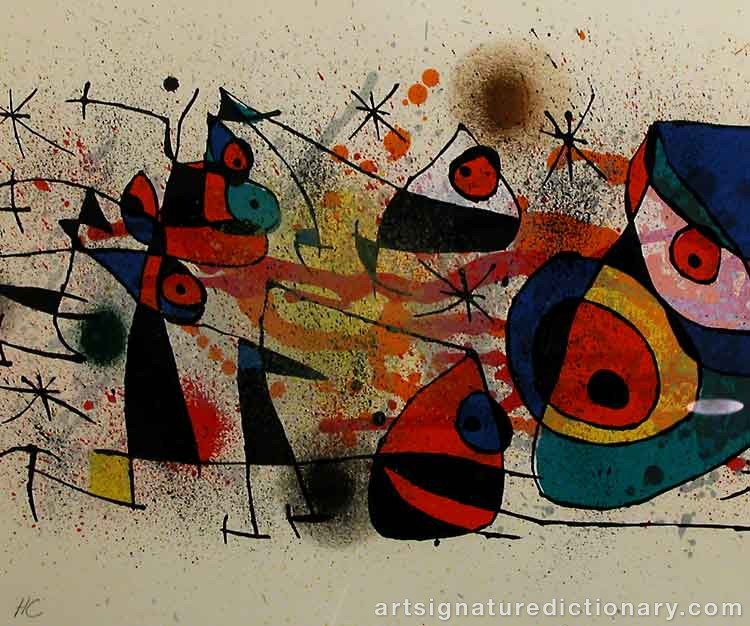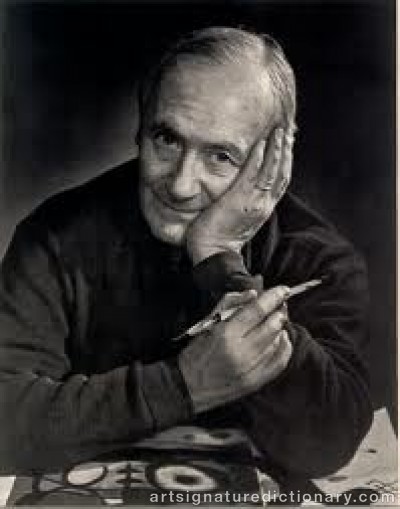
Joan MIRO
1893–1983, Spain/France
Also known as: Miró I Ferrà
Signatures & monograms
72 signatures and monograms by Joan Miro on drawing, graphic, print, painting and watercolour. Compare authentic and documented counterfeit examples to study signature characteristics.
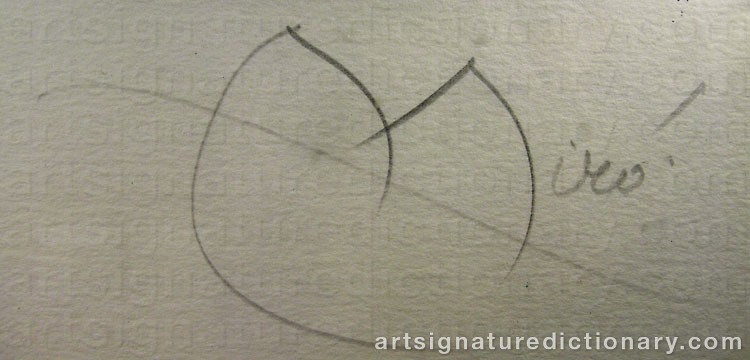
Signature proven counterfeit
Lithograph, composition, untitled, signed "Miro" numbered 18/50, 65x87 cm. Police were contacted by staff at a minor auction house in Stockholm Sweden on the grounds that they had a lithograph signed Miro who appeared not to be genuine. The painting was submitted to the sale of the daughter of an elderly sick man who bought the lithograph in April 1990. The painting has been examined by experts and found to be a forgery and is now forfeit.
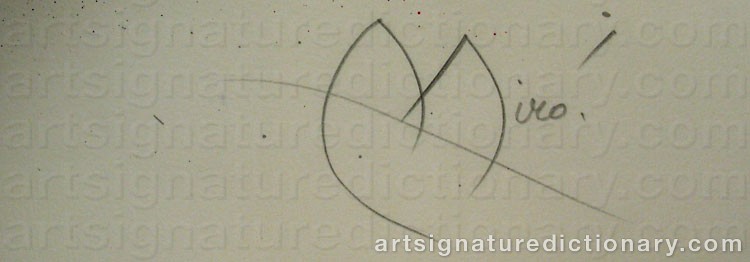
Signature proven counterfeit
Lithograph, Title: Ceramiques, signed "Miro" numbered EA, 1974, 42x62 cm. A private person submitted, in October 2007, this lithograph to a major auction house in Stockholm for sale. They became suspicious that it could be a forgery. Police were called who took the painting seized for further investigation. The lithograph was sent to Spain and was examined by Rosa Maria Malet, expert at the Centre d´Studio d´Art Contemporani, Fundació Joan Miró, in Barcelona. The assessment found that it is a forgery and not signed by Joan Miró. Submitter is not suspected of having committed the crime. Note: The district court decides that on the front of lithography, in close proximity to the signature, shall be permanently affixed word COUNTERFEIT and also be applied at the middle of the back. Thereafter, the lithograph is returned to the owner.
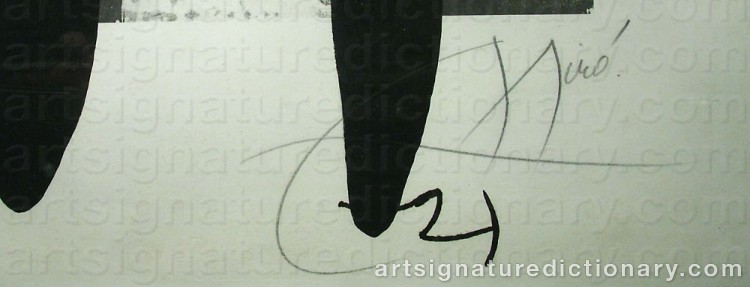
Signature proven counterfeit
"La Captive". In January 1991 Swedish police arrest a Swedish citizen suspected to have sold counterfeit artwork of Miro for about 10 million Swedish crowns (approximately Euro one million). The investigations in Sweden had shown that the forgery came from Denmark. 664 sheets of Joan Miro, 143 sheets of Marc Chagall and 1.251 sheets of Salvador Dali was found and also some correspondence and financial material. The main man in Denmark had sold for more than 3.3 mil. Danish crowns to foreign galleries. Many of Miro graphics was printed on paper without watermark, despite the fact that the catalog had stated that they were printed on paper with watermark. Several of the pieces were printed on paper manufactured after Miro's death. The case leeds to the U.S., where American police on 9.7.1991 seized between 60,000 and 100,000 forged graphics, including over 15,000 Miro. Investigation showed that the main man in Denmark in the years 1989 and 1990 had bought more than 1.000 pieces Miro graphics from a company in New York for a price of ca. 1.1 million U.S. dollar.
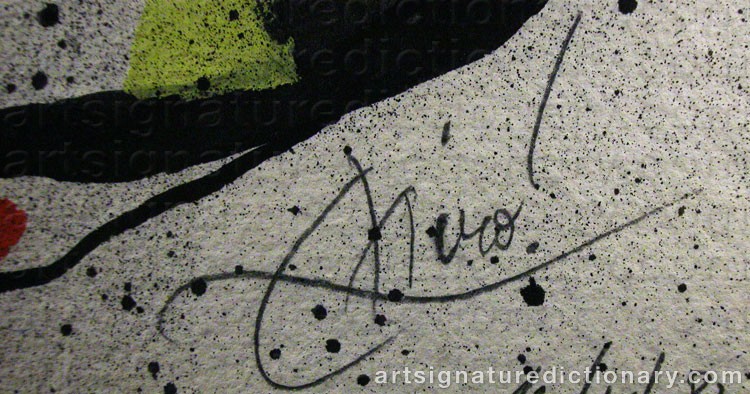
Signature proven counterfeit
Mixed media on paper, composition, signed "Miro", 33x26 cm. In the mid 1980s, the counterfeiting of Joan Miró and Antoni Tàpies appear on the market. Some were provided with certificate of authenticity by different people, who claimed to be experts on Mirò and Tàpies. Eventually it was understood that it was the fakes. All tracks led to an apartment in Södermalm in Stockholm in Sweden. The 39-year-old man was arrested by police. More counterfeit paintings signed Miró and Tàpies appeared. The buyers said that the paintings came from the 39-year-old man. Antoni Tàpies used sometimes by a special technique when he used his palms and soles, as elements in his paintings. Five of the fake paintings were done with this technology. Hand and footprints could be traced to the 39-year-old man - it was his own! He admitted now that it was he who carried out the forgeries. He stated that he made some 50 fakes. Of these, 34 pieces found in connection with the investigation. Even today, it pops up counterfeits, probably done by the same person. A couple of the fake Miró the paintings was sold at Christie's in New York for over 100,000 Swedish crowns each. All anträffade paintings were fake autographed pastiches done in order to mimic Tàpies and Miró painting. The 39-year-old man was sentenced in 1986 to prison terms of one year and three months for aggravated fraud for signature forgery.
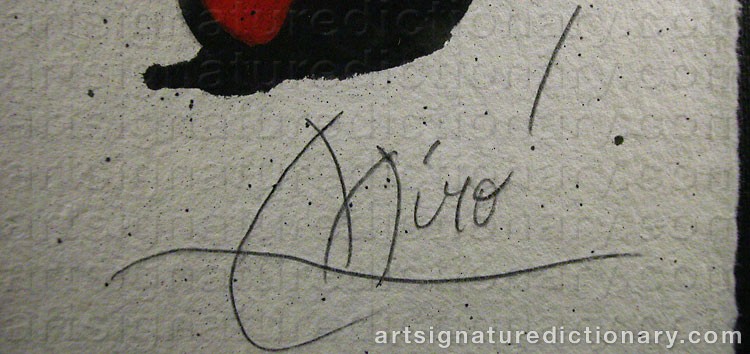
Signature proven counterfeit
Mixed media on paper, composition, signed "Miro", 33x28 cm. In the mid 1980s, the counterfeiting of Joan Miró and Antoni Tàpies appear on the market. Some were provided with certificate of authenticity by different people, who claimed to be experts on Mirò and Tàpies. Eventually it was understood that it was the fakes. All tracks led to an apartment in Södermalm in Stockholm in Sweden. The 39-year-old man was arrested by police. More counterfeit paintings signed Miró and Tàpies appeared. The buyers said that the paintings came from the 39-year-old man. Antoni Tàpies used sometimes by a special technique when he used his palms and soles, as elements in his paintings. Five of the fake paintings were done with this technology. Hand and footprints could be traced to the 39-year-old man - it was his own! He admitted now that it was he who carried out the forgeries. He stated that he made some 50 fakes. Of these, 34 pieces found in connection with the investigation. Even today, it pops up counterfeits, probably done by the same person. A couple of the fake Miró the paintings was sold at Christie's in New York for over 100,000 Swedish crowns each. All anträffade paintings were fake autographed pastiches done in order to mimic Tàpies and Miró painting. The 39-year-old man was sentenced in 1986 to prison terms of one year and three months for aggravated fraud for signature forgery.
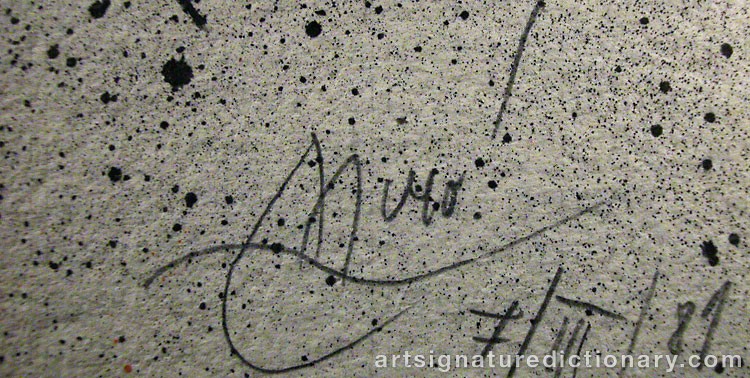
Signature proven counterfeit
Mixed media on paper, composition, signed "Miro", 33x25 cm. In the mid 1980s, the counterfeiting of Joan Miró and Antoni Tàpies appear on the market. Some were provided with certificate of authenticity by different people, who claimed to be experts on Mirò and Tàpies. Eventually it was understood that it was the fakes. All tracks led to an apartment in Södermalm in Stockholm in Sweden. The 39-year-old man was arrested by police. More counterfeit paintings signed Miró and Tàpies appeared. The buyers said that the paintings came from the 39-year-old man. Antoni Tàpies used sometimes by a special technique when he used his palms and soles, as elements in his paintings. Five of the fake paintings were done with this technology. Hand and footprints could be traced to the 39-year-old man - it was his own! He admitted now that it was he who carried out the forgeries. He stated that he made some 50 fakes. Of these, 34 pieces found in connection with the investigation. Even today, it pops up counterfeits, probably done by the same person. A couple of the fake Miró the paintings was sold at Christie's in New York for over 100,000 Swedish crowns each. All anträffade paintings were fake autographed pastiches done in order to mimic Tàpies and Miró painting. The 39-year-old man was sentenced in 1986 to prison terms of one year and three months for aggravated fraud for signature forgery.

Signature proven counterfeit
Gouache. This fake painting is sold in Stockholm in the early 80's for 40,000 Swedish crowns (approx. 4.000 Euro). Painted by a forger living in Stockholm. He was sentenced for having produced some 50 paintings by the artists Joan Miro and Antoni Tàpies. The man was convicted by his own hand-and footprints in the color of the Tapie-forgeries. After an expert assessment and judgment declared that the painting is not genuine. It is a forgery. This motif appears as the cover of the book Ruffels of abuses in gold frame.
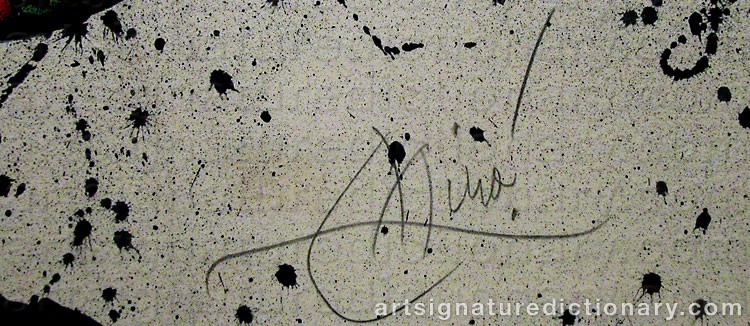
Signature proven counterfeit
Gouache, composition, signed "Miro" 30/11/83, 38x57 cm. In December 1983, the police confiscated two gouache signed Miro. A renowned expert in Stockholm had been asked by an art dealer to make an expert assessment. The expert thought then that the two the paintings seemed suspicious. Several experts felt that the two gouacherna was not genuine. But there was a written statement from a reputable Swedish expert on Joan Miro who considered the works to be genuine. On the back is written: "This piece of art in my opinion is an original done by Joan Miro certifies ...". The continued reconnaissance work led to the forger was arrested in spring 1986. After an expert assessment and judgment declared that the painting is not authentic. It is a forgery.

Signature proven counterfeit

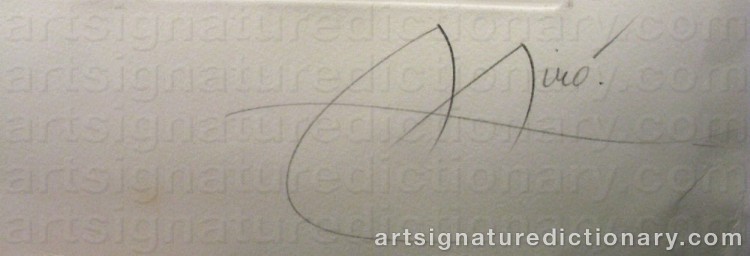
Signature proven counterfeit
In 2004 a large-scale art forgery case was exposed during the Salvador Dali centenary exhibition at the Wanha Satama fair centre in Helsinki. The art dealer concerned had forged and sold hundred of Dali graphics as well as graphics of some other internationally known artists as Rembrant, Braque, Chagall, Léger, Miro and Picasso. The exhibition was led by five persons, the owner and his son, two sellers and a woman. The police confiscated all the artwork. Both paintings and signatures were forged. This artwork of Miro was sold at a price of Euro 20.800.
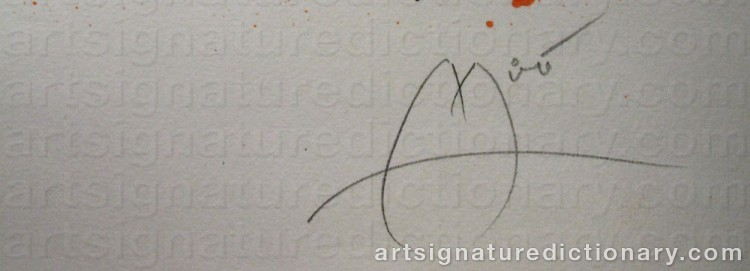
Signature proven counterfeit
In 2004 a large-scale art forgery case was exposed during the Salvador Dali centenary exhibition at the Wanha Satama fair centre in Helsinki. The art dealer concerned had forged and sold hundred of Dali graphics as well as graphics of some other internationally known artists as Rembrant, Braque, Chagall, Léger, Miro and Picasso. The exhibition was led by five persons, the owner and his son, two sellers and a woman. The police confiscated all the artwork. Both paintings and signatures were forged.
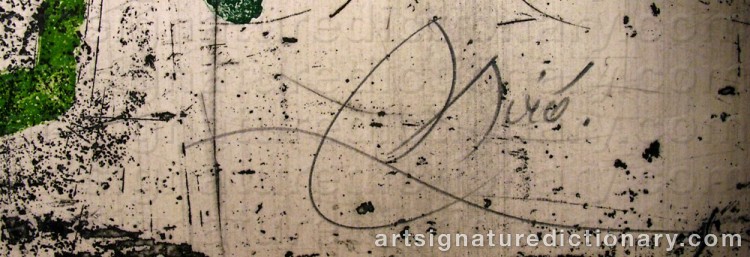
Signature proven counterfeit
In 2004 a large-scale art forgery case was exposed during the Salvador Dali centenary exhibition at the Wanha Satama fair centre in Helsinki. The art dealer concerned had forged and sold hundred of Dali graphics as well as graphics of some other internationally known artists as Rembrant, Braque, Chagall, Léger, Miro and Picasso. The exhibition was led by five persons, the owner and his son, two sellers and a woman. The police confiscated all the artwork and sent away for examination to the Gala-Salvador Dalí Foundation in Spain. Both paintings and signatures were forged. This artwork of Miro was sold at a price of Euro 22.000.

Signature proven counterfeit
In 2004 a large-scale art forgery case was exposed during the Salvador Dali centenary exhibition at the Wanha Satama fair centre in Helsinki. The art dealer concerned had forged and sold hundred of Dali graphics as well as graphics of some other internationally known artists as Rembrant, Braque, Chagall, Léger, Miro and Picasso. The exhibition was led by five persons, the owner and his son, two sellers and a woman. The police confiscated all the artwork. Both paintings and signatures were forged. This artwork of Miro was sold at a price of Euro 27.000.

Signature proven counterfeit
In 2004 a large-scale art forgery case was exposed during the Salvador Dali centenary exhibition at the Wanha Satama fair centre in Helsinki. The art dealer concerned had forged and sold hundred of Dali graphics as well as graphics of some other internationally known artists as Rembrant, Braque, Chagall, Léger, Miro and Picasso. The exhibition was led by five persons, the owner and his son, two sellers and a woman. The police confiscated all the artwork. Both paintings and signatures were forged. This artwork of Miro was sold at a price of Euro 11.500.

Signature proven counterfeit
In 2004 a large-scale art forgery case was exposed during the Salvador Dali centenary exhibition at the Wanha Satama fair centre in Helsinki. The art dealer concerned had forged and sold hundred of Dali graphics as well as graphics of some other internationally known artists as Rembrant, Braque, Chagall, Léger, Miro and Picasso. The exhibition was led by five persons, the owner and his son, two sellers and a woman. The police confiscated all the artwork. Both paintings and signatures were forged. This artwork of Miro was sold at a price of Euro 21.000.

Signature proven counterfeit

Signature considered genuine

Signature considered genuine

Signature considered genuine

Signature considered genuine

Signature considered genuine

Signature considered genuine
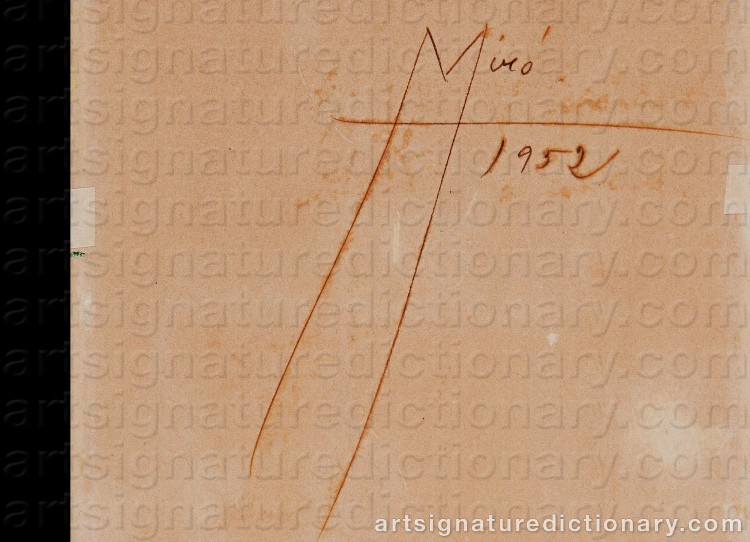
Signature considered genuine

Signature considered genuine

Signature considered genuine

Signature considered genuine

Signature considered genuine
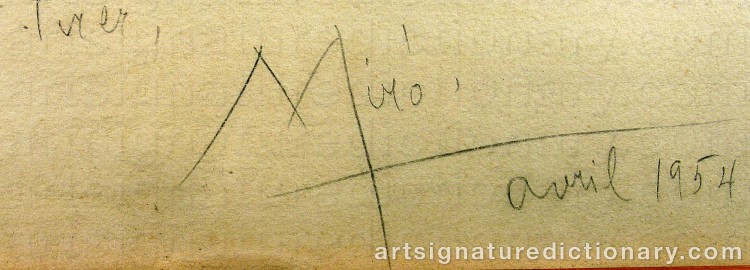
Signature considered genuine

Signature considered genuine
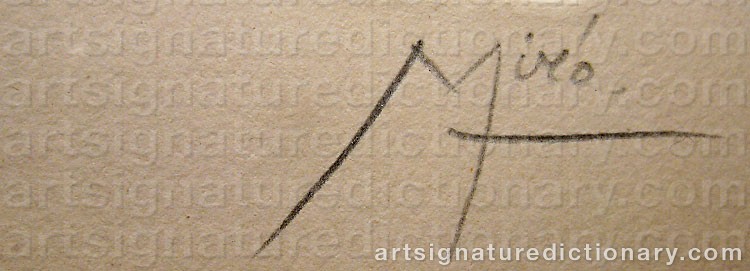
Signature considered genuine
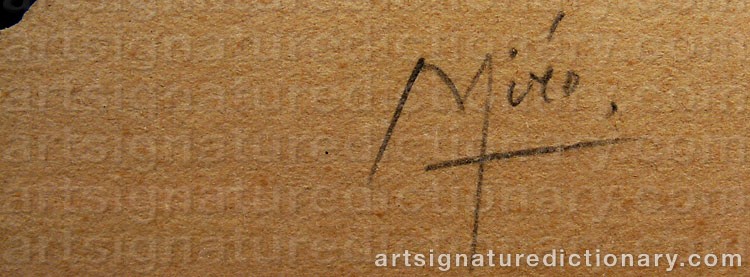
Signature considered genuine

Signature considered genuine
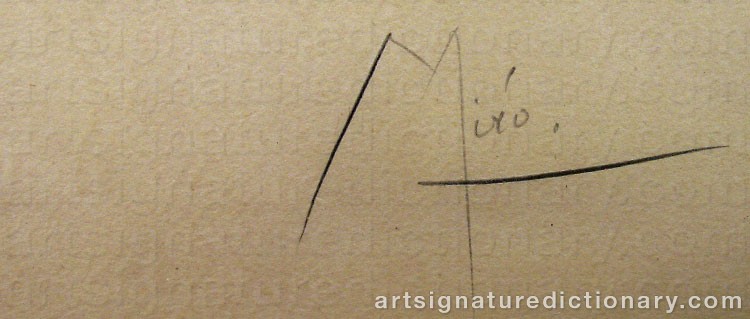
Signature considered genuine

Signature considered genuine

Signature considered genuine
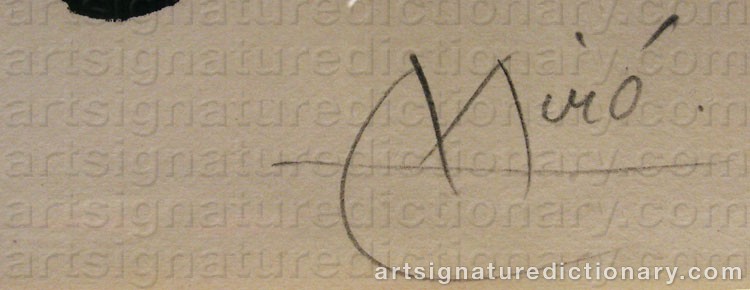
Signature considered genuine
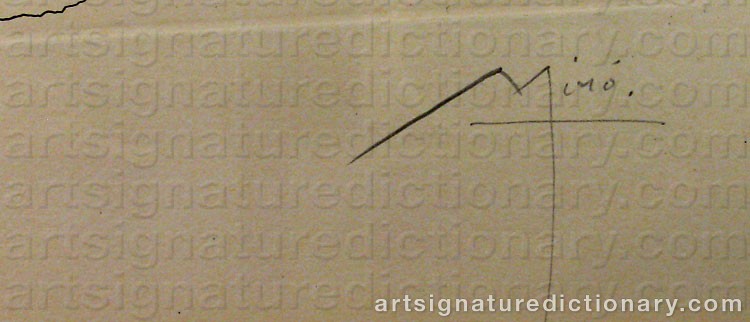
Signature considered genuine
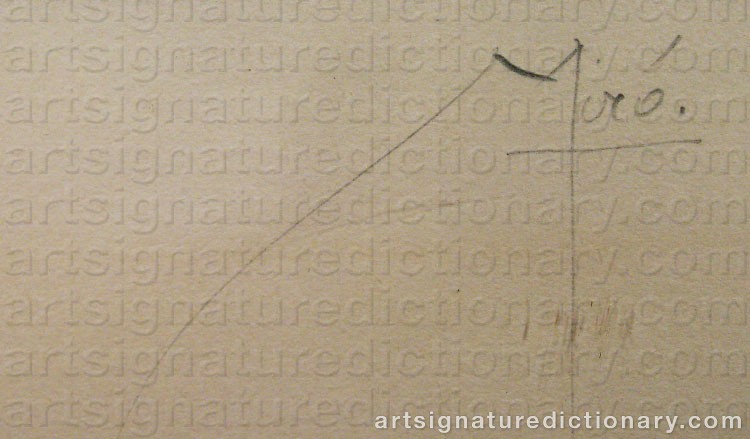
Signature considered genuine

Signature considered genuine

Signature considered genuine
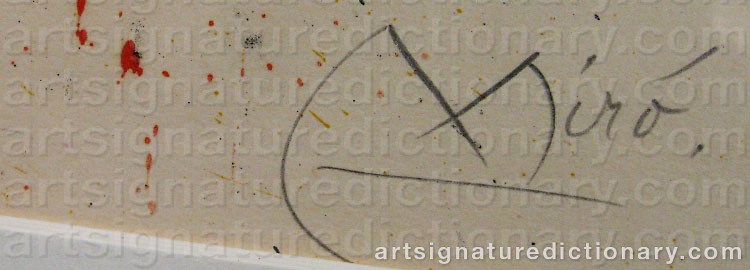
Signature considered genuine
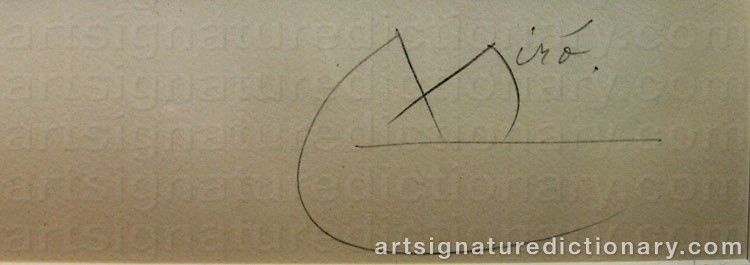
Signature considered genuine

Signature considered genuine

Signature considered genuine
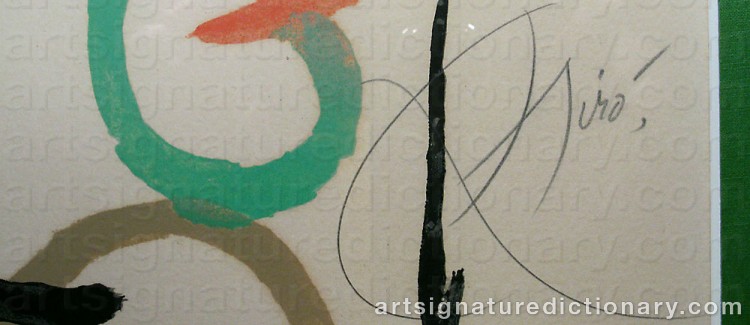
Signature considered genuine

Signature considered genuine
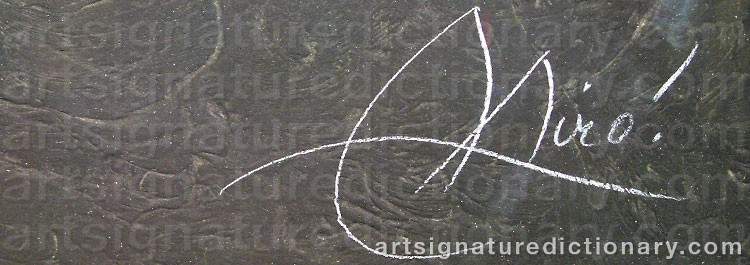
Signature considered genuine
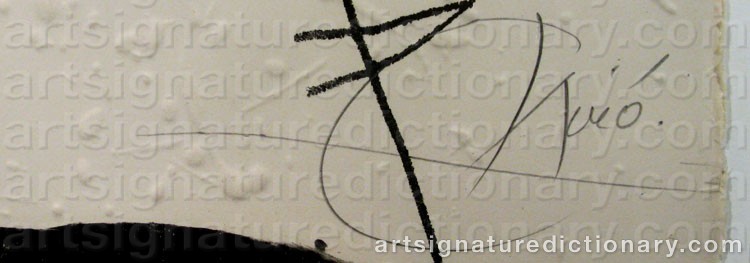
Signature considered genuine

Signature considered genuine

Signature considered genuine

Signature considered genuine

Signature considered genuine

Signature considered genuine

Signature considered genuine

Signature considered genuine

Signature considered genuine

Signature considered genuine
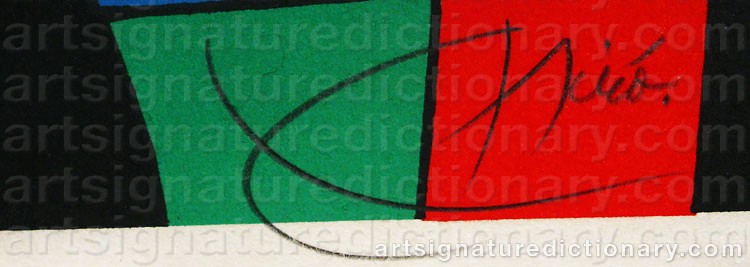
Signature considered genuine

Signature considered genuine

Signature considered genuine

Signature considered genuine

Signature considered genuine

Signature considered genuine
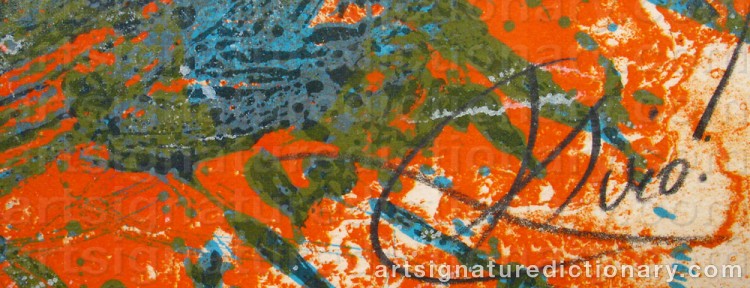
Signature considered genuine
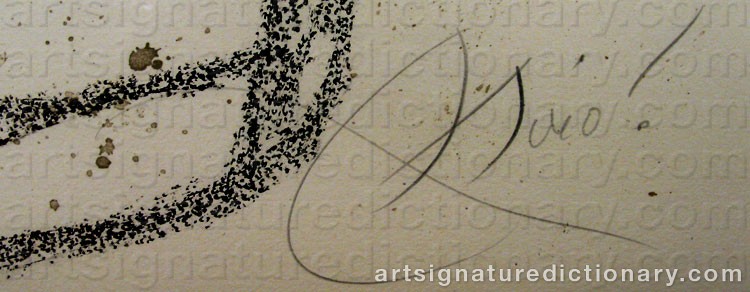
Signature considered genuine

Signature considered genuine
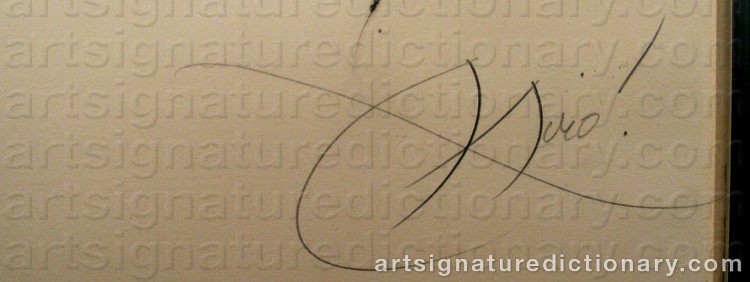
Signature considered genuine

Signature considered genuine
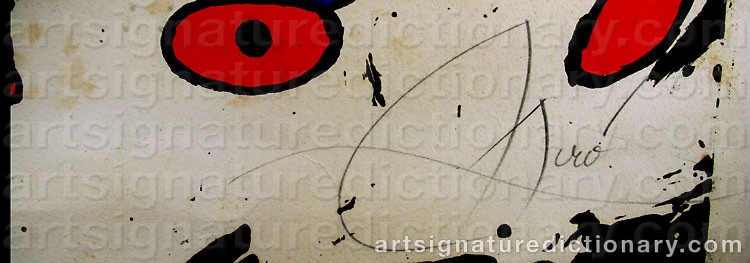
Signature considered genuine
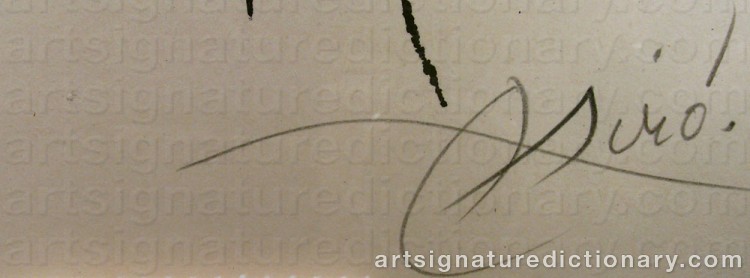
Signature considered genuine

Signature considered genuine
Explore other artists
Discover other notable artists who were contemporaries of Joan MIRO. These artists worked during the same period, offering valuable insights into artistic movements, signature styles, and authentication practices. Exploring related artists makes it easier to recognize common characteristics and artistic conventions of their era.







